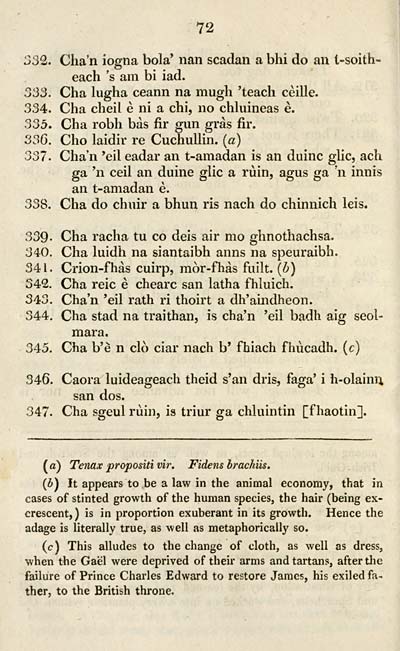Download files
Complete book:
Individual page:
Thumbnail gallery: Grid view | List view

72
332. Cha'n iogna bola* nan scadan a bhi do an l-soith-
each 's am hi iad.
333. Cha lugha ceann na mugh 'teach cèiUe.
334. Cha cheil è ni a chi, no chluineas e.
335» Cha robh bas fir gun gras fir.
330. Cho laidh- re Cuchullin. (a)
337. Cha'n 'eil eadar an t-amadan is an duinc glic, ach
ga 'n ceil an duine glic a ruin, agus ga 'n innis
an t-amadan è.
338. Cha do chuir a bhun ris nach do chinnich leis.
339. Cha racha tu co dels air mo ghnothachsa.
340. Cha luidh na siantaibh anns na speuraibh.
341. Crion-fhàs cuirp, mòr-fhàs fuilt. (b)
342. Cha reic è chearc san latha fhluich.
343. Cha'n 'eil rath ri thoirt a dh'aindheon.
344. Cha stad na traithan, is cha'n 'eil badh aig seol-
mara.
345. Cha b'è n clo ciar nach b* fhiach fhùcadh. (c)
346. Caora luideageach theid s'an dris, faga' i h-olainu
san dos.
347. Cha sgeul ruin, is triur ga chluintin [f haotin].
( a) Tenax propositi vir. Fidens brachiis.
(b) It appears to be a law in the animal economy, that in
cases of stinted growth of the human species, the hair (being ex-
crescent,) is in proportion exuberant in its growth. Hence the
adage is literally true, as well as metaphorically so.
(c) This alludes to the change of cloth, as well as dress,
when the Gael were deprived of their arms and tartans, after the
failure of Prince Charles Edward to restore James, his exiled fa-
ther, to the British throne.
332. Cha'n iogna bola* nan scadan a bhi do an l-soith-
each 's am hi iad.
333. Cha lugha ceann na mugh 'teach cèiUe.
334. Cha cheil è ni a chi, no chluineas e.
335» Cha robh bas fir gun gras fir.
330. Cho laidh- re Cuchullin. (a)
337. Cha'n 'eil eadar an t-amadan is an duinc glic, ach
ga 'n ceil an duine glic a ruin, agus ga 'n innis
an t-amadan è.
338. Cha do chuir a bhun ris nach do chinnich leis.
339. Cha racha tu co dels air mo ghnothachsa.
340. Cha luidh na siantaibh anns na speuraibh.
341. Crion-fhàs cuirp, mòr-fhàs fuilt. (b)
342. Cha reic è chearc san latha fhluich.
343. Cha'n 'eil rath ri thoirt a dh'aindheon.
344. Cha stad na traithan, is cha'n 'eil badh aig seol-
mara.
345. Cha b'è n clo ciar nach b* fhiach fhùcadh. (c)
346. Caora luideageach theid s'an dris, faga' i h-olainu
san dos.
347. Cha sgeul ruin, is triur ga chluintin [f haotin].
( a) Tenax propositi vir. Fidens brachiis.
(b) It appears to be a law in the animal economy, that in
cases of stinted growth of the human species, the hair (being ex-
crescent,) is in proportion exuberant in its growth. Hence the
adage is literally true, as well as metaphorically so.
(c) This alludes to the change of cloth, as well as dress,
when the Gael were deprived of their arms and tartans, after the
failure of Prince Charles Edward to restore James, his exiled fa-
ther, to the British throne.
Set display mode to: Large image | Transcription
Images and transcriptions on this page, including medium image downloads, may be used under the Creative Commons Attribution 4.0 International Licence unless otherwise stated. ![]()
| Early Gaelic Book Collections > Blair Collection > Mackintosh's collection of Gaelic proverbs, and familar phrases > (92) |
|---|
| Permanent URL | https://digital.nls.uk/80463190 |
|---|
| Description | A selection of books from a collection of more than 500 titles, mostly on religious and literary topics. Also includes some material dealing with other Celtic languages and societies. Collection created towards the end of the 19th century by Lady Evelyn Stewart Murray. |
|---|
| Description | Selected items from five 'Special and Named Printed Collections'. Includes books in Gaelic and other Celtic languages, works about the Gaels, their languages, literature, culture and history. |
|---|

